Tactical Action Rules for Nearly Marking and for Closing the Penetration of the Direct Opponent in Possession of the Ball
Abstract
This study examines the trends in the use of action rules for nearly marking and for closing the penetration of the opponent in possession of the ball, by the players of the finalist teams (France and Qatar) at the World Championship held in Qatar. Our goal is to provide a training process for the young players in line with the development of high performance handball. The results indicate a trend in nearly marking and in closing the game space in outer barrage, used by the defenders of the French team. The tactical action rules for nearly marking/ closing in frontal linear form as well as internal (throwing arm positioning) are frequently used behaviours with the players of the Qatar team. The process of training young players should consider the development of the nearly marking action and that of closing the game space specific to the outer barrage (in addition to the “classical” throwing arm positioning or frontal linear closures). Depending on the placement of the pivot located inside the defence, players should know specific behaviours of this rule.
Keywords: sports, handball, high-performance, defence, individual tactical action
Introduction
Handball game analysis involves multiple issues. One of them lies in the dimension space-time
(Prisăcaru, 2010: 37). During attack, players must find individual, relational and collective solutions in
a relatively small area, in continuous motion, in a relatively short and predetermined time. In dialectical
manner, the defence must implement “obstacles” in order to disrupt the attack players and recover the
ball through an optimal uptake of the game area and through a reduction in the constrained time
allocated to the opponents.
In this framework, several defence means (“obstacles”) can be identified in the literature. Kunst-
Ghermănescu et al. (1983: 117) describe “the following qualities and requirements that prove to be the
most important for the players to solve all defence tasks”: mental and physical qualities, technical and
tactical processes, principles of individual and collective game. Among those, the individual tactical
actions are mentioned as “the most convenient ways to use technical procedures specific to defence”
(Kunst-Ghermănescu et al., 1983: 125). Nearly markingand closing the penetration to the gate are two
of the individual tactical actions listed and detailed with great interest by this author. Bota and Bota
(1987: 124) also make reference to these individual tactical actions in light of the methodological
requirements necessary to achieve the defence game. The rules often cited by Kunst-Ghermănescu et
al. (1983: 126-127) are “the placement on the opponent’s direction of movement” and “the defender’s
positioning on the opponent’s throwing arm side”. In the same sense, Sotiriu (1998: 82) reminds us of
“the throwing arm covering” and “using the body in attacking the player in possession of the ball” as
appropriate procedures for the tactical situations.
Costantini (2004: 86) evokes general principles of defence to highlight fundamental behaviours,
actions known and proposed in order to achieve a genuine defensive act. Among these fundamentals,
the role of no. 2 playing position defenders (the intermediate defender) and the importance of
considering the pivot’s positioning, in order to tailor their interventions, are underlined. With regard to
the two central defenders (no. 3), in the context of 6-0 defence type, they are advised to add a
collaboration/ mutual complementarity in their functioning relationship with the defender no. 2
(Costantini, 2004: 78).
Bayer (1993: 130) refers to the forms used by the defence system employed, the original placement,
the division of roles in organizing collective and relational determinations of players (translational
motion, alignment, misalignment, sharing people in defence, slipping) as various means which can be
used in defence. To achieve adapted tactical actions, the relations between players require that certain
operating rules be followed, such as ex-centring the opponent with the ball, game ban behind the
defenders, crowding on the ball positioning part, mutual aid, chaining tactical actions (Bayer, 1993:
127-130).
Following these theoretical concepts from the relevant literature, we will define the rules of nearly
marking and those of closing the penetration of the direct opponent in possession of the ball actions,
and also the forms of their use.
(throwing arm placement): ex-centres the defender forward to the sideline, a space in which effectiveness is diminished (Bayer, 1993: 128); positioning/ harassment with intent to close
the central area of defence (internal closure); the defender is placed on the line that unites the
attacking player to the centre of the gate and slightly laterally according to the opponent’s throwing
arm (Kunst-Ghermănescu et al., 1983: 126).
(outer barrier): the defender leads the attacking player inwards in a central space where there is more defensive density; positioning/ harassment with intent to bar the access to the
exterior defence zone (external locking).
: the defender controls frontally the line player; positioning/ harassment with parallel closing to the attacking player’s front line positioning (frontal linear closure).
The objective of our study is to reveal the trends of the tactical action rules in marking nearly and of
closing the opponent’s with the ball penetration, in the context of the preparation and/or the performing
of the individual offensive manoeuver, to provide a training process for young players, in adequacy
with the evolution of the handball game.
1.1. Issue
The defence types are more difficult to categorize in modern handball (Costantini, 2004: 112) and
one of the effective defence means to disrupt the offensive organizations is the optimal use of
individual tactical actions of marking nearly and of closing the opponent’s penetration to the gate. If
defence systems are becoming more and more variable during an offensive action, in search of a
favourable separation of the game area, we wonder about the rules that guide the defenders
predominantly during tactical nearly marking and closing the space game in front of the opponent with
the ball.
Materials and methods
. The observation of the two teams (France and Qatar), finalists of the World Handball
Championship 2015, in six matches (France vs. Qatar, Spain, Argentina; Qatar vs. Poland, France,
Germany) using the video system and the live watching of the semi-finals and finals of the World Cup.
Eighty-seven individual defensive actions were indexed and analysed in this context. The analysis was
conducted on eight players, the intermediate defenders and the centres opposite the pivot position, in
the 6-0 defence system type, intending to exit towards the player with the ball (outside space 7-8m);
during actions carried out in the fourth phase of defence; when facing offensive actions like threat/
overtaking manoeuver/ interval intrusion, and in the game phases in full team (6 versus 6). They
managed to neutralize the defensive actions against the right-handed right back; against the players
from the 9m line, using the cross relationship; before shooters to the gate outside line 9m carried out
without prior use of overtaking; during the application of “the passive play” rule.
The means employed were: the listing of actions, observation grids, statistical tables, charts,
“Dartfish” software.
Results
The outer space (internalization) closing rule is used in priority by the French players (66%) (Fig.
1). The main actors are D. Narcisse (100%), intermediate defender, explosive, medium build player
(Table 1), and L. Karabatic (70%), central defender, strong and very large-sized. The other central
defender, N. Karabatic, large-sized player with qualities of strength and power, shows specific
functional primary intent of this rule, with a frequency of 58% (Fig. 2).
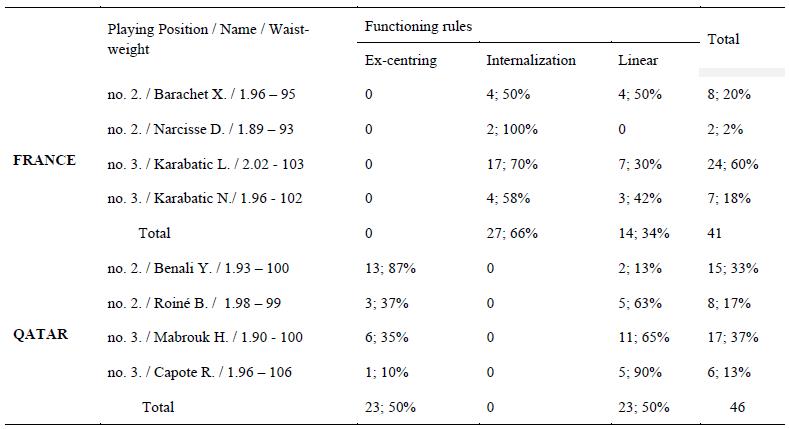
With the Qatar players, we do not observe defensive intentions specific to the outer space closing
rule (Table 1). The rule of closing the interior space (ex-centring) is used by Qatar players in equal
manner (50%) compared to frontal linear closure (50%) (Fig. 1). The intermediate defender, Y. Benali,
large-sized player (Table 1) with power qualities, uses primarily the closing of the space of penetration
to the inside rule (87%). The central defender, H. Mabrouk, medium build and powerful, having
qualities of strength, and B. Roiné, tall and explosive player, apply this rule secondly, in point of
frequency (35% and 37%) (Fig. 3).
No defensive behaviour of closing the game to the inside is observed in the French team players (Table 1).
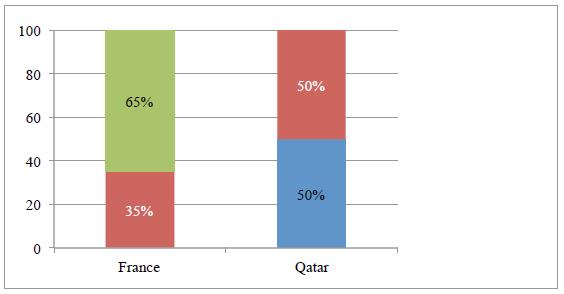
The frontal linear closure rule is used secondly. in point of frequency, by the French team, with a
frequency of 34% (Fig. 1). X. Barachet, large-sized player, with power qualities, situated on the
intermediate defender position, uses the original linear frontal behaviour, equally with that of the outer
closure (50%). L. Karabatic applies this rule relatively secondary in point of frequency (42%) (Fig. 2).
Qatari players are concerned about playing in frontal linear closure with a frequency of 50% from
the observed actions. The main identified defenders are R. Capote (90%), H. Mabrouk (65%), B. Roiné
(63%).
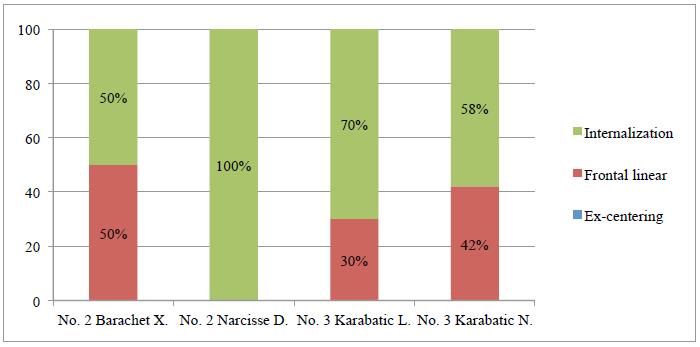
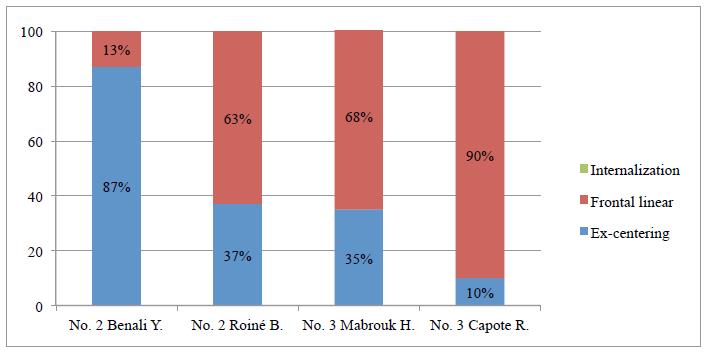
Discussions and conclusions
Following this analysis, we find that the rule of the tactical actions ofnearly marking and closing
the penetration of the direct opponent in possession of the ball in outer barrage have an important
significance to French players. They tend to internalize, to encourage the densification of the game
space on the offensive pivot's positioning, placed inside the defence (Fig. 4 and 5). The intermediate
defence positions often use this rule with a relatively large depth (outside the 8 feet space) directly in
front of the opponent. The centre defenders located opposite the pivot position often use the same rule.
With the second pivot infiltration inside the defensive system, the isolated central defender is also
concerned with the outer space closing and to incite the production of offensive density on the pivot
location side in the most crowded area of defence.
The inner (for ex-centring) and frontal linear closure rules are often used by Qatar players (Fig. 6
and 7). These are “classical” rules of operation in which the main concern is to reject/ an ex-centring
offensive player to the remote sectors and reduced game areas.
Illustration of defensive tactics action rules against the opponent with the ball:
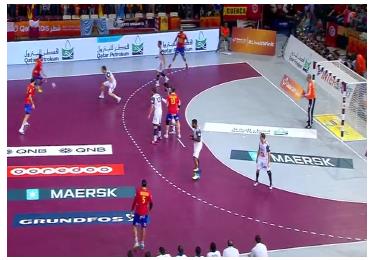
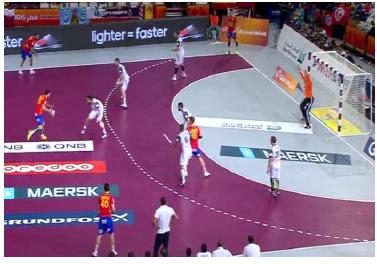
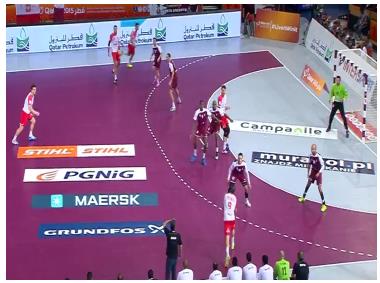
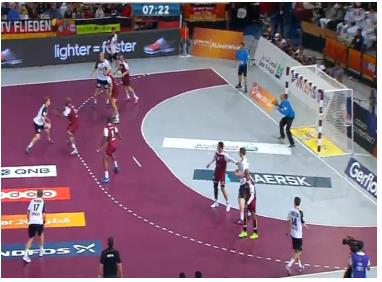
In this context, we conclude that the variability of the defence system occurred during an offensive
action may be subject to specific individual action tactics rules. Players are guided by a predefined
manner in choosing behaviours and operational forms of defence intervention against the opponent
with the ball. They may be modified/ adapted quickly depending on the context of achieving dialectical
defender - forward action in real time (now).
The internalization of the offensive action rule, used by the French defenders’ central block,
performed in order to impose tight game spaces to the attacking players in the centre of defence and
offensive pivot placement in the centre of the defence, is one of the specific types of current handball
defensive intervention practiced in high performance.
4.1. Training directions
The results of our study show authentic defensive features regarding the usage of tactical action
rules of nearly marking and of closing the opponent with the ball through the constant use of exterior
defensive space closure revealed by the French world champion team. Following this observation, the
young player training process should take into account the specific characteristics of this defensive
game rule.
Considering the defensive organization players’ profile, their morphological, physical, motor,
perceptual, decision and mental qualities, the internalization rule should be part of the full technical
and tactical range of defenders that perform on the intermediate and central defence positions.
The main training directions:
the perception / threat assessment and decision / timing / optimal intervention distance in front of the direct attacker in possession of the ball or without the ball;
adapted motor organization and the positioning outside the 7-8m defensive space, slightly misaligned outwards in relation to the goal axis and to the direct opponent and opposite the opposition pivot
location;
dynamic balance, speed specific over short distances to surprise the attacker and to prevent him to act towards the outer defensive sector where the opposition pivot is not positioned; strength and power to
master the offensive entering to the low defensive density game areas;
the mind in order to convey the young players the desire to win defensive duels and to prove the opponent ineffective in high density defence game space;
understanding outer space closure game rule: the player has to understand why, when, where, how to use defence external space closing, depending on his possibilities and on the technical and tactical
behaviours encountered in the offensive strategy.
4.2. Study limits
The case study has some limitations. One of them is reflected in the limited amount of data and
analysed subjects. The subjectivity of qualitative data interpretation is also a limiting factor. A more
thorough analysis entailing more subjects and data, and a more congruent means of statistical
validation could provide a more relevant consisted to our research.
References
Bayer, C. (1993). Handball. La formation du joueur (3ème édition). Paris: Vigot. [Collection Sport
+ Enseignement].
Bota, I., & Bota, M. (1987). Handbal. București: Sport-Turism.
Costantini, D. (2004). Handball, «Cahiers des sports». Paris: Revue EP.S, 86-112.
Kunst-Ghermănescu, I., Gogâltan, V., Jianu, E., & Negulescu, I. (1983). Teoria și metodica handbalului. București: Editura Didactică și Pedagogică.
Prisăcaru, I. R. (2010). Analiza tacticii și sistemelor de joc ofensive la echipele de elită din Europa în vederea optimizării atacului la echipele românești de „top” - handbal masculin (Teză de doctorat). UNEFS, București.
Sotiriu, R. (1998). Handbal, Antrenament, teorie, metodică. București: Garold.
Copyright information

This work is licensed under a Creative Commons Attribution-NonCommercial-NoDerivatives 4.0 International License.
About this article
Publication Date
10 June 2016
Article Doi
eBook ISBN
978-1-80296-010-5
Publisher
Future Academy
Volume
11
Print ISBN (optional)
-
Edition Number
1st Edition
Pages
1-509
Subjects
Sports, sport science, physical education
Cite this article as:
Prisacaru, I. R. (2016). Tactical Action Rules for Nearly Marking and for Closing the Penetration of the Direct Opponent in Possession of the Ball. In V. Grigore, M. Stanescu, & M. Paunescu (Eds.), Physical Education, Sport and Kinetotherapy - ICPESK 2015, vol 11. European Proceedings of Social and Behavioural Sciences (pp. 46-53). Future Academy. https://doi.org/10.15405/epsbs.2016.06.7

